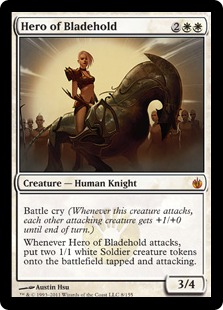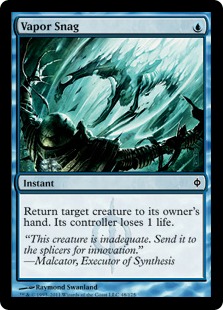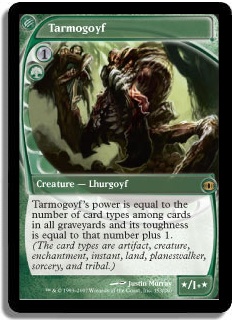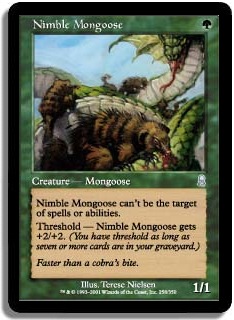This past weekend, the StarCityGames.com Open Series came to the nation’s capital: Washington, DC. While I was unable to make it to the tournament on Saturday, I did get to watch a lot of the coverage (and even made Top 8 of the biggest Legacy Open to date!). I’ve been playing a lot of Standard with M13 on Magic Online lately and noticed a few new decks popping up, but mostly I’m infatuated with some new takes on some of the format’s more popular archetypes.
Specifically, I’m talking about U/W Delver and Wolf Run Ramp. While both of these decks are known entities, I think that the newer versions of both present more powerful threats than anything we’ve seen in Standard for quite some time.
After all, when did people stop thinking this card was good?
Creatures (15)
Lands (21)
Spells (24)

During the last SCG Invitational, Gerry Thompson convinced me to play Hero of Bladehold in my U/W Delver sideboard, mostly as a gigantic threat for decks like ramp but also because it’s just an inherently powerful threat. Sometimes, you just need to have a high threat density to combat a format full of removal, and adding Hero of Bladehold to the already efficient, powerful threat suite gave the deck some staying power in matchups where it really needed it.
With that said, I think Delver has become a little inbred in order to defeat the mirror, but I was very excited to see Charles Gindy defeat his quarterfinals opponent by casting Hero of Bladehold then using Mental Misstep to protect it from Vapor Snag. This kind of Magic is what I love: tempo driven games where even the slightest mistake can cost you the game or match. I think that this could be the best new look that Delver has had in quite some time, and I’m glad that I don’t have to play Restoration Angel anymore.
And that’s the realization I had. Maybe Restoration Angel was only good because of its large size. People forgot that you don’t need equipment to win. When your threats are good enough on their own, then having to pair your creature up with a Sword of War and Peace or Runechanter’s Pike just isn’t necessary. In the current Standard, you need all of your threats to be able to close the game by themselves or generate enough tempo or card advantage to help push you ahead. Delver of Secrets, Geist of Saint Traft, and Hero of Bladehold all apply enough pressure to the opponent on their own so that you don’t have to overextend against a control opponent.
While Snapcaster Mage can’t provide you with that same kind of pressure, he provides a much different service. I’m not going to go into detail about why Snapcaster Mage is good. I’ve already spent countless words on that particular subject, but there is a reason why he is largely considered to be the best creature in Delver, even though the deck is not named after him. You don’t need equipment to make Snapcaster Mage good. You occasionally want equipment to make him better, but you don’t need it. After the first game, it can even be a huge liability if your opponent brings in cards like Divine Offering or Steel Sabotage. In those scenarios, you will often sink into a tempo black hole, and that is not something you can afford.
While this new iteration of Delver didn’t quite win the tournament, I do think there is a very good reason it made it all the way to the finals. Gindy is a great player and I’m sure that had a lot to do with it, but just watching him play the deck on camera made it feel like he was playing a different game. No one else seemed to have Mental Misstep, and those that did weren’t protecting a threat as powerful as Hero of Bladehold so theirs were less important. When you’re playing a game dictated entirely by tempo, there are two important factors that decide the outcome:
- Cost of Protecting your Threat – This can be done a number of ways, but you want your protective spells to be as cheap as possible. In Legacy, this generally means playing Daze and Force of Will. In Standard, it means playing Mental Misstep and Cavern of Souls. Both of these cards are essentially "free" and can protect your threat(s).
- Power Level of your Threats – This is less tangible, but it really depends on a given matchup. Restoration Angel is a "powerful" threat but is generally considered much easier to race than a Hero of Bladehold. Even though Restoration Angel can provide virtual card advantage from Blinking your creatures or flashing in to block an opposing creature, Hero of Bladehold can kill your opponent in just a few attacks.
…
While it can be argued that Restoration Angel is "better" for Delver decks because it has flash, I don’t think that particular ability matters as much right now. In Standard, nearly every deck is considered to be good or bad based on the power level of the threats it can put into play. Sure, Restoration Angel is a great creature, but not that many decks are afraid of it. On a clear board, you get to attack for three points of flying, and it usually takes between four and seven attacks to win the game. It is difficult to kill, and it carries Runechanter’s Pike better than most everything else.
Hero of Bladehold doesn’t need equipment to make it better. Hero of Bladehold can kill the opponent in just over two attacks…by itself. If that isn’t argument enough to at least try Hero of Bladehold, then I don’t really know what would be able to change your mind. This is a hostile format, and every turn where you don’t kill your opponent they’re building their arsenal and clogging the board. Do you really think another deck playing Restoration Angel is afraid of yours? Every deck is afraid of Hero of Bladehold. And the rest of your deck should just compound this problem.
The whole point of U/W Delver is to make cards like this better! Vapor Snag makes Geist of Saint Traft look like the best creature ever printed. Vapor Snag has seen play in a Legacy deck that made the finals of a Grand Prix, mostly because of Geist of Saint Traft. Vapor Snag doesn’t make Restoration Angel look better; it makes Runechanter’s Pike and Sword of War and Peace look better, and most creatures in Standard can wield those two equipment quite well. There is a reason why you just flat-out win games when your opponent tries to win by blocking your Geist of Saint Traft. That reason is that you generate tempo with cards like Mutagenic Growth, Gut Shot, and Vapor Snag. These tempo-based cards are usually only good when you’re on the offensive, so you need all of your threats to be potent.
In Legacy, these threats are generally considered to be some of the best creatures in Magic.
If you notice something about these creatures, it is that they are much more powerful than their mana cost would suggest. When combined with blue cantrip spells, cheap removal, and cheap disruption, all of these creatures become much stronger. Without one of these threats to present pressure, your Dazes, Lightning Bolts, Spell Pierces, and Wastelands are just embarrassing. You give your opponent their most important resource: time. When you combine any combination of these disruptive spells along with any one of the threats listed above, you’re at the helm of the best deck in Legacy.
Standard is currently no different. Gut Shot is one of the best removal spells for a reason. Everyone wants to apply pressure early or accelerate into bigger threats faster than their opponent. But none of the spells in your deck actually do anything if you aren’t combining them with an efficient threat. Do you think Vapor Snag actually counts as removal? There is a reason that when you fall behind with a Delver deck, it is incredibly hard to dig yourself out of that hole. You sacrifice the chance to win the game by card advantage so that you can win the game with tempo. Vapor Snag is virtually a dead card on defense. Â
…
Another exciting archetype showcased in DC was Wolf Run Blue. While this deck isn’t exactly "new," it is an underused take on an old, popular archetype. Wolf Run Ramp has been a top tier deck for almost as long as Kessig Wolf Run and Primeval Titan have been in Standard. Ever since Brian Kibler won Pro Tour Dark Ascension with the archetype, it has been one of the premier decks in the format, even if it falls off in popularity from time to time. With that said, this new take on the archetype could be the boost it needs to go out of Standard with a bang!
Creatures (14)
Lands (26)
Spells (20)
Sideboard

Obviously, without Primeval Titan this deck will be much worse or cease to exist altogether. Until we enter a new era with a Return to Ravnica, expect Primeval Titan to continue pushing other decks around. They ramp, they play fatties, they play removal, and now they even have card selection! While the release of M13 means that a lot of cards are about to rotate out of Standard, we still have a decent amount of time left to play with our old favorites.
Josh Ravitz recently won a PTQ with this archetype before the release of M13, but I think the new set just makes the deck better! Thragtusk is a strong addition to the creature suite. While it can provide your deck with a solid threat against the tempo decks, it can also gain ground against the aggressive decks unlike any other creature in Standard. Thragtusk is a powerful threat as well as a powerful defensive maneuver, which is a winning combination for a ramp-style deck. Without Thragtusk, I feel like this archetype would be a little soft to the more aggressive decks in the format. Without cheap sweeper cards in the maindeck, you could be easily overrun by an aggressive Zombies draw, but Thragtusk can singlehandedly pull you back into the game!
So what is the red for, exactly? Bonfire of the Damned is pretty…darn powerful when your deck has access to a ton of mana. Alongside cards like Frost Titan, Bonfire of the Damned can be huge. Traditional sweepers for Wolf Run Ramp include Slagstorm and Whipflare, but I don’t know if that’s where the deck wants to be anymore, at least not in the first game. Whipflare is only good against a scant few decks, whereas Bonfire can be devastating at virtually any point in the game whether or not it is miracle cast.
Ponder allows the deck to take advantage of having 7-8 miracle spells. You can effectively use Temporal Mastery in two ways. Since an early miracle functions similarly to Explore, you can use Temporal Mastery as a ramp spell that draws you a card. Later Time Walks can win games on the spot thanks to your Titans and Phantasmal Images. When you have a card that is so versatile and both sides are important to your archetype, the addition of it seems like a no-brainer.
The rest of the deck is pretty straightforward. We have ramp spells, Titans, and a mana base that only a mother could love. Sure, the mana isn’t really that bad, but it isn’t that good either. Cavern of Souls can be awkward on occasion, but resolving your Titans against Delver is paramount. Without the vulnerability to Mana Leak, you can survive much more easily. Delver can’t really race a Titan when you’re searching up Glimmerposts, and they certainly can’t kill them. Vapor Snag can only get you so far.
I’ve seen different versions of this deck running around on Magic Online over the last few weeks, and I’m really happy that someone finally took the reins and did well with it at a StarCityGames.com Standard Open! The fact that it was Reid Duke is just icing on the cake! Â
…
While I don’t have a lot of live events to attend in the coming weeks, I will be playing in some Magic Online PTQs. I think that Delver will be my first choice for mostly obvious reasons, but I’m not opposed to trying something different. The Wolf Run Blue deck seems really powerful and is definitely something I’d be interested in taking on a test drive. I’ll try to pick up the cards over the next few days, and I might even record a video with it!
My goal is to provide you with a quality product that you can enjoy and to keep you hungry for more! If you have any requests or recommendations, I would love to hear them in the comments. For whatever it’s worth, I do read every one of them, regardless of whether or not I respond to them.
Over the next few weeks, Brian Braun-Duin and I will be bringing you Select playtest videos that will cover various formats. For now, we have done only Standard, but this week we will be filming a Legacy video that will go up Friday of next week. If you love Legacy, then come show your support. Share our video with your Magic friends on Facebook. Tweet about our videos and let people know whether or not you like them and what you think we could do to improve them. We’re always looking for ways to make our content better, but we can’t do that without your feedback.
If you like what we’re doing, spread the word! If you’re learning something from our videos, then tell us exactly what it is and why it is important to you. We will be doing our best to improve these videos as we go, but we’re still in the learning process. We thank you guys for your support and hope to continue bringing you awesome videos every Friday! If you enjoy those, then be sure to check out my Magic Online videos that (usually) go up on Tuesdays.
I take great pride in the work I’m doing for the Magic community, and I only wish to give you the best experience possible.
Thanks for reading.
strong sad on Magic Online
@strong_sad on Twitter (Follow me!)





